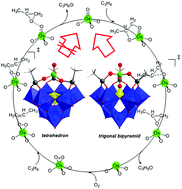Computational study on epoxidation of propylene by dioxygen using the silanol-functionalized polyoxometalate-supported osmium oxide catalyst†
Abstract
Anchoring of unimolecular metal oxide onto appropriate supports is a promising and attractive approach for designing efficient metal–oxide-based catalysts from the perspective of economic and environmental sustainability. In the present paper, anchoring of osmium (Os) oxide onto silanol-functionalized polyoxometalates (POMs) to form a single-site supported Os-POM catalyst, in which the isolated osmium tetroxide was tris-grafted on a silanol-functionalized POM platform, has been studied in detail for catalytic oxidation of propylene with dioxygen by using density functional theory (DFT) calculations with the M06L functional. The results derived from the molecular geometry, electronic structure, and Os![[double bond, length as m-dash]](https://www.rsc.org/images/entities/char_e001.gif) O bonding feature for this Os-POM catalyst show that (i) rotation of the anionic center subunit of the silanol-functionalized trilacunary POM ligand leads to a coordinated environment conversion from a tetrahedron to a trigonal bipyramid around the transition metal Os center; (ii) a detailed comparison shows that the trigonal bipyramid configuration is the most stable species and provides a large Os
O bonding feature for this Os-POM catalyst show that (i) rotation of the anionic center subunit of the silanol-functionalized trilacunary POM ligand leads to a coordinated environment conversion from a tetrahedron to a trigonal bipyramid around the transition metal Os center; (ii) a detailed comparison shows that the trigonal bipyramid configuration is the most stable species and provides a large Os![[double bond, length as m-dash]](https://www.rsc.org/images/entities/char_e001.gif) O distance and (iii) possesses a matched orbital level for epoxidation of propylene to epoxypropane. The calculated free energy profiles for the epoxidation of propylene show that the rate-determining step is desorption of the first epoxypropane molecule from the Os center. Electronic structure analysis along the reaction pathway shows that the Os-POM catalyst serves as an electrophile, accepting electrons from the propylene π bonding orbital to the π* antibonding orbital of the Os-POM catalyst to break the Os
O distance and (iii) possesses a matched orbital level for epoxidation of propylene to epoxypropane. The calculated free energy profiles for the epoxidation of propylene show that the rate-determining step is desorption of the first epoxypropane molecule from the Os center. Electronic structure analysis along the reaction pathway shows that the Os-POM catalyst serves as an electrophile, accepting electrons from the propylene π bonding orbital to the π* antibonding orbital of the Os-POM catalyst to break the Os![[double bond, length as m-dash]](https://www.rsc.org/images/entities/char_e001.gif) O bond during the oxygen transfer process. Oxygen transfer to the terminal carbon atom of propylene is more favored than the bridging carbon atom because the electron-donating methyl substituent in propylene makes the terminal carbon atom more nucleophilic and accessible for the electrophilic attack by the Os
O bond during the oxygen transfer process. Oxygen transfer to the terminal carbon atom of propylene is more favored than the bridging carbon atom because the electron-donating methyl substituent in propylene makes the terminal carbon atom more nucleophilic and accessible for the electrophilic attack by the Os![[double bond, length as m-dash]](https://www.rsc.org/images/entities/char_e001.gif) O bond. Cleavage of dioxygen on the Os-POM catalyst is a barrier free process via a quintet-to-singlet state intersystem crossing. The ability of the POM platform to accept and stabilize excess electrons from the Os center effectively promotes the oxygen transfer process, and thus is favorable for epoxidation of propylene by dioxygen.
O bond. Cleavage of dioxygen on the Os-POM catalyst is a barrier free process via a quintet-to-singlet state intersystem crossing. The ability of the POM platform to accept and stabilize excess electrons from the Os center effectively promotes the oxygen transfer process, and thus is favorable for epoxidation of propylene by dioxygen.



 Please wait while we load your content...
Please wait while we load your content...